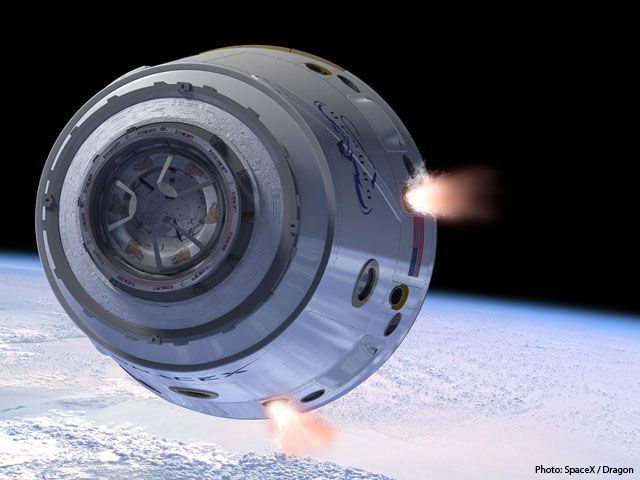Private Spaceship to Make 1st Space Station Flyby Thursday

The unmanned Dragon space capsule, launched by commercial company SpaceX on Tuesday morning, is preparing to rendezvous with the International Space Station for the first time early Thursday (May 24).
Dragon has spent today (May 23) catching up in orbit with the 240-mile-high (386 kilometer) laboratory, and plans to fly within 1.5 miles (2.5 km) of it early tomorrow. The meeting will be the first time a privately built vehicle approaches the station, a $100 billion collaboration between five international space agencies.
"Dragon fly by of Space Station planned for 12:47 am California time. All systems green," SpaceX's billionaire founder and chief designer, Elon Musk, wrote on Twitter today. That time translates to 3:47 a.m. EDT (0747 GMT).
If all goes well on Thursday, SpaceX will send Dragon even closer to the station on Friday (May 25), approaching near enough so that astronauts onboard can reach out and grab the unmannedcraft with the space station's robotic arm and attach it to the outpost.
"There have been only four nations, or groups of nations, that have berthed or docked a spacecraft to the International Space Station: Europe, Russia, the United States of course, and Japan," SpaceX president Gwynne Shotwell said during a briefing before the launch. "So we really stand in awe of having the opportunity to attempt this."
Dragon lifted off from Cape Canaveral Air Force Station early Tuesday atop SpaceX's Falcon 9 rocket. The robotic capsule, which measures 14.4 feet tall (4.4 meters) and 12 feet wide (3.7 m), is packed with crew rations and clothing, supplies like batteries and a laptop, and 15 science experiments designed by students. [Launch Photos: SpaceX's Dragon Blasts Off for Space Station]
During the early morning hours of Thursday, Dragon will establish communication with the space station using its "COTS Ultra-high frequency Communication Unit." It will also run a test of one of its navigation systems, called Relative GPS, which uses the relative positions of Dragon and the space station to determine the capsule's location.
Sign up for the Live Science daily newsletter now
Get the world’s most fascinating discoveries delivered straight to your inbox.
Some of the space station's six-man crew will participate in the tests on Thursday, including watching over the flyby and sending instructions to Dragon to turn on a strobe light to make sure the capsule can receive commands from the crew — a critical ability for berthing.
After these activities have been performed in close proximity to the station, Dragon will retreat, looping out in front, aboveand then behind the laboratory in a racetrack pattern at a distance between 4 and 6.2 miles (7 and 10 km) away.
The results of these tests will help NASA decide if Dragon will be allowed to attempt to berth with the station the next day.
Dragon's mission is a test flight partially funded by NASA's COTS program (Commercial Orbital Transportation Services), which aims to develop private vehicles capable of filling the shoes of the retired space shuttles for cargo delivery to the space station.
If all objectives are met on this demonstration flight, SpaceX will be cleared to begin flying the 12 supply delivery missions the company is contracted for at a price of $1.6 billion. The first of these could come this autumn, SpaceX officials have said.
SpaceX (officially Space Exploration Technologies Corp.) is based in Hawthorne, Calif. It was founded by billionaire entrepreneur Elon Musk, who also started online payment service PayPal.
Live coverage of the rendezvous activities will begin on NASA TV Thursday at 2:30 a.m. EDT (0630 GMT). A news conference will follow at 10 a.m. EDT (1400 GMT).
This story was provided by SPACE.com, a sister site to LiveScience. You can follow SPACE.com assistant managing editor Clara Moskowitz on Twitter @ClaraMoskowitz. Follow SPACE.com for the latest in space science and exploration news on Twitter @Spacedotcom and on Facebook.












